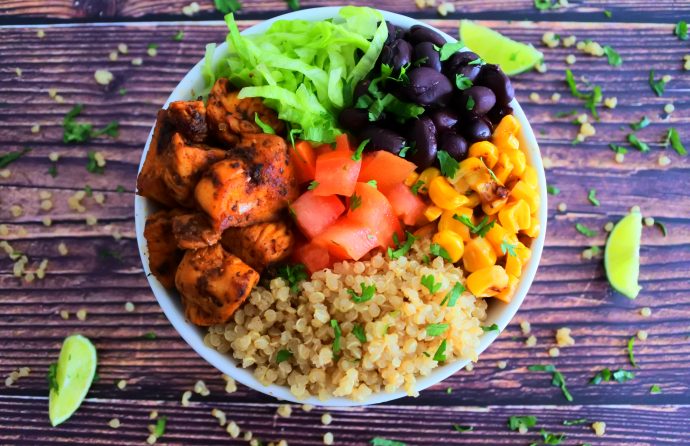Disclosure: This post may contain affiliate links.
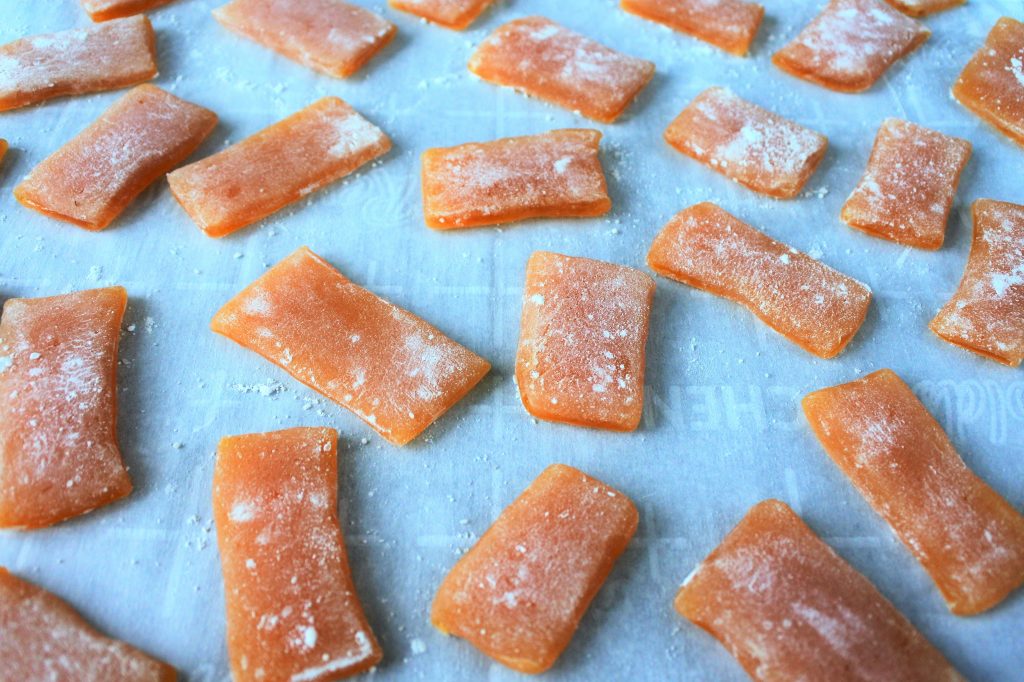
Soft, chewy, honey-sweetened and wonderfully spiced with freshly grated zesty ginger, these poppable chews are delicious, easy to make and good for you too!
💕Here’s why you’re going to absolutely love these delicious ginger bites:
- These chews are made using wholesome ingredients like freshly grated ginger and raw honey.
- They are gluten-free and vegetarian friendly.
- They are great for helping with nausea and indigestion.
- It’s a great candy to keep on hand especially during flu-season!
- You can adjust the heat level from the ginger to suit your own personal preference.
- They are soft, chewy, and flexible (like in the below image 👇).

Are these ginger chews good for you?
Both ginger root and honey are known for having many health benefits from being a great anti-nausea relief which helps with motion sickness or even morning sickness as well as aiding in digestion which can give relief to people who suffer from acid reflux (which makes this a great after meal chew!)
More to that, both ginger and honey contain both antibacterial and anti-inflammatory properties that have the combined ability to sooth sore throats, reduce inflammation, open up the sinuses, and even helps boost your immune system, so these chews are so much more than just a sweet treat and it’s one natural remedy recipe you’ll want to keep on hand (especially during cold and flu season!)
Now that we’ve talked about why these spicy ginger chews are arguably good for you…
Here’s what you need to make them:

- Ginger Root: Ensure you’re using raw, freshly grated ginger root for this recipe. Note that you can adjust the spice level of these chews using different amounts of ginger.
- 2 tbsp – mild ginger flavor with more sweetness.
- 3 tbsp – well-balanced notes of ginger and sweetness.
- 4 tbsp – a strong and fiery ginger heat with just enough sweetness < personally this is my favorite option but be aware it can be very potent and spicy.
- Raw Honey: This touch of sweetness adds both flavor and boasts the benefits of containing antioxidants as well as being great for soothing your cough, sore throat and digestive system.
- Sugar: I highly recommend using finely blended raw organic cane sugar or evaporated cane juice sugar.
- Water: This is our main liquid that will be used to make our ginger decoction.
- Starch: We’ll be using a touch of starch (either cornstarch or tapioca starch) just to coat our made-and-cooled candy to keep it from sticking together. You can also use a mix of starch and icing sugar if preferred.
A note about honey:
When it comes to the honey you use, I recommend using raw or pure honey. Using fake, processed or adulterated honey (this is usually honey that is combined with corn or some other type of syrup to reduce costs) will affect the texture and crack point of your chew. I’ve personally tested a batch with this kind of honey and what I found is that the chews never set up right and tends to remain soft and sticky, and requires more than double the amount of starch to control. Chews that are formed start to melt into a puddle once shaped and left to sit.
In my experience you tend to find these on grocery store shelves and they tend to be cheap. Despite that, I’ll be honest in saying that it’s hard to spot the fakes just by looking at them. Buying honey from local keepers or buying brands that are transparent in their process is a great way to ensure you’re getting the purest and best quality honey. My personal favorite brand of honey comes from Keez Beez. They’re not a sponsor and have no clue who I am but I honestly can’t say enough good things about the company and the quality of the honey itself. It’s really good stuff!
Can I omit the honey to make these vegan-friendly?
Sure! You can replace the honey with equal parts of sugar (aka a 1:1 ratio) if preferred.
Now, let’s make some candy!

We’ll start by combining our water and ginger and boiling it down into what’s called a decoction.
A decoction is simply a method of extracting the essence from a root or bark by boiling it down into a concentrated amount (this is similar to an infusion which extracts the essence of flowers, herbs or even fruit by steeping it in hot water). Basically think of it as making a very strong and concentrated ginger tea.
We’ll be using 2 cups of water and boiling it low and slow until 1 cup of concentrated ‘ginger tea’ remains.

Strain all the bits of ginger out of your liquid using a fine strainer. Once cool enough to handle, squeeze all the liquid out of the ginger itself and you can either discard it, or bring it to room temperature and then freeze it for later use (I like using mine for ginger teas!).
Give your saucepan a quick rinse to get out and leftover bits of ginger, and return your decoction to the pan.

Add in the sugar and honey to your saucepan…
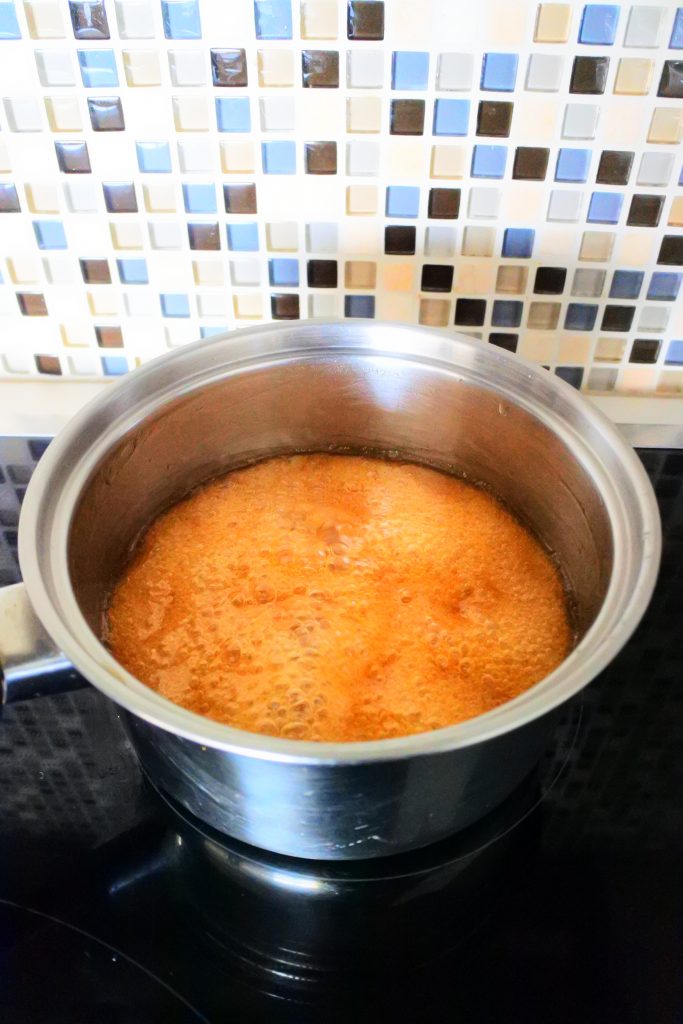
…and bring it to a bubbling simmer. Keep your heat low and let the liquid slowly reduce into a thick syrup without allowing it to boil over. If you like you can stir it every so often with a clean spatula to keep the edges of the pot clean as it cooks down.
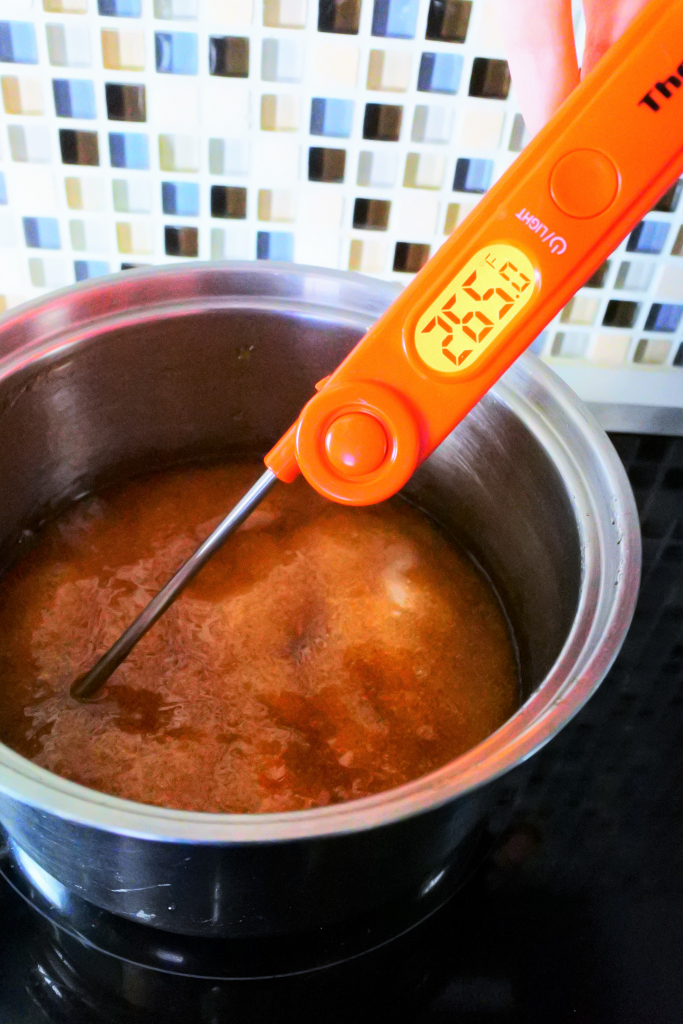
This stage takes about an hour but you’ll want your candy to reduce down into a thick, honey-like consistency that reads between 260° F – 265° F on a thermometer.
Now, a word of warning: In the beginning it takes a long time to go from thread to softball, but keep in mind that with each stage, as the sugar concentration in the candy intensifies, the cook time between stages becomes significantly less so it’s essential to keep an eye on it once it starts to thicken. I’ve had some of my test batches go from 260° F – 275° F in about a minute.

What if I don’t have a candy thermometer?
If you don’t have a thermometer you can use the water drop test to check the consistency of your candy. Keep in mind you should be aiming to attain the Hard Ball Stage. Using a clean spoon, stream a tsp of your syrup into a bowl or glass of cold water from a few inches above the water. Our candy will go through various stages.
- Thread Stage – 223 – 234° F – 80% sugar concentration. Your syrup will simply pour off your spoon in a stream. In cold water, your syrup will dissolve and mix into the water and dissipate.
- Soft Ball Stage – 235 – 244° F – 85% sugar concentration. Once streamed into cold water, it will create a soft blob that you can push around with your finger. If lifted from the water it will be very soft and start melting and flattening between your fingers.
- Firm Ball Stage – 245 – 250° F – 87% sugar concentration. At this stage, a bit of the syrup streamed into a clean bowl of cold water will form a firmer ball that can be shaped in the water and lifted out. Once squeezed between your fingers, it will be malleable and shapeable but sticky.
- Hard Ball Stage – 251 – 265° F – 92% sugar concentration. At the hard ball stage (which is the stage we need) a stream of syrup dropped into water will form a firm blob that holds its shape both in and out of the water. When squeezed firmly between your fingers, there should be slight give but the candy should still be shapeable.
Soft Crack Stage– 266 – 290° F – 95% sugar concentration. At this stage the stream of syrup with solidify once it hits the water into firm strands. Once removed from the water, the blob will be tough but slightly flexible before breaking / shattering if tapped.
At the soft crack stage the candy has gone a step too far to be chewy ginger candy. I’m only making mention of it so you know what to look out for and what temperatures you want to avoid.
So what is the best temperature? What happens at other temperatures?
I’ve tested this recipe at various temperatures and here’s what I found:
- 255-259° F produces a very soft, melt-in-the-mouth chew. A lot of starch or icing sugar is needed to keep the pieces from sticking together and the pieces will slightly lose their shape when resting at room temp but it is delicious despite melting away quickly.
- 260-265° F gives the best results for making gin-gin style chews that are soft yet chewy.
- At 275° F it sets and hardens to the point that it will shatter / break if you lightly tap it with a knife yet the pieces will still have a bit of flex to them before snapping. Personally I don’t like my ginger candies at this stage as they’re not really great to chew on and they stick to your teeth in a bad way that will make your dentist sad. 😔
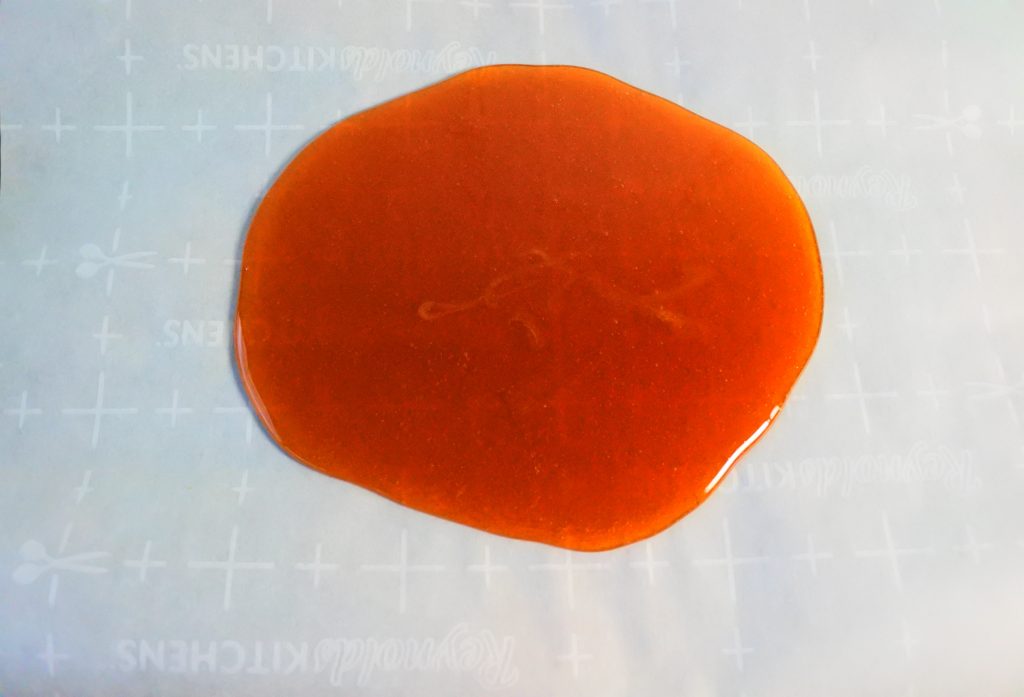
Once at the right temperature / consistency, pour your candy out onto a tray lined with parchment paper (there’s no need to spread it, it will naturally do so on its own) and let it cool for 30-60 minutes until it’s firm, cooled, and slightly tacky to the touch. The surface will be shiny and glossy and I know it’s not going to look like a whole lot and you’ll wonder if you didn’t make enough but trust me that this recipe makes about 50 strips!
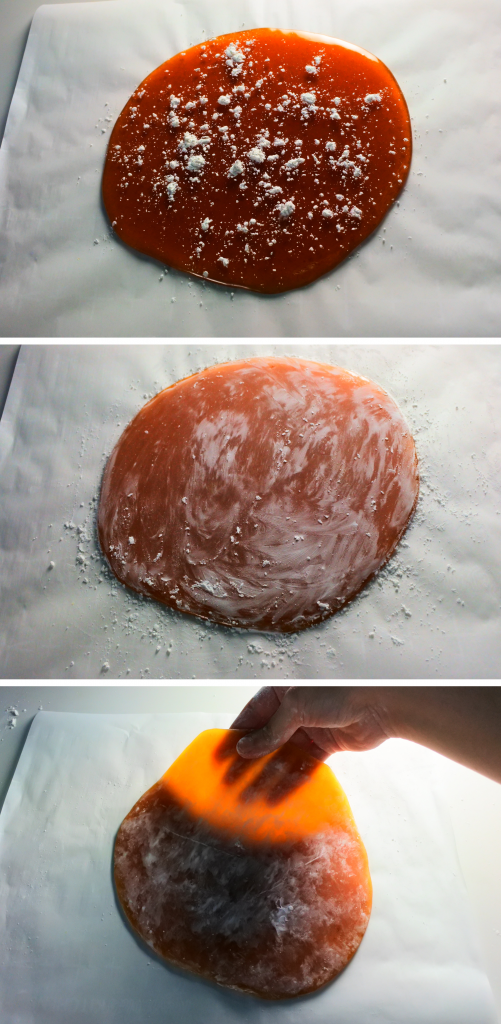
This is my favorite part…the fun part! With you candy cooled to the touch, dust the surface with a touch of cornstarch before peeling it off the parchment (it should lift off easily in one solid sheet). Flip it over and dust the other side with more starch.

Using a starch dusted knife, a pizza cutter, or even heavy duty stainless steel scissors to cut your candy sheet into strips and then individual-sized pieces.
Helpful tip: If you’re using a pizza cutter confidence is key, you need to go in strong and rolling it back and forth in one motion to avoid it getting stuck midway and having to tear it out.

And there you have it, wonderful strips of homemade honey-ginger candy chews made using wholesome and delicious ingredients.

And as a bonus you can choose the shape of your chews. If you’re not a fan of the strips, you can roll the strips into tight rolls to make gumdrop-shaped ginger bites.

Be sure you dust your chews with starch or powered sugar to keep them from sticking to each other and store them in a cool, airtight container at room temp for 6 weeks for the best freshness and taste. Or in the fridge for up to 4 months.
Ginger Honey Chews
Ingredients
- 3-4 tbsp fresh ginger finely grated
- 2 cups water
- 1/4 cup honey
- 3/4 cup evaporated cane juice sugar or raw cane sugar
- cornstarch or tapioca starch to dust
Instructions
- In a small saucepan, bring the grated ginger and 2 cups water to a low boil until 1 cup of liquid remains. Strain and remove the ginger from the decoction and return the strained liquid to the saucepan.
- Add the sugar and honey to the ginger decoction and bring it to a boil, stirring until the sugar dissolves. Once dissolved, set to a low simmer and allow it to cook until it reaches the hard-ball stage (260-265°F on a candy thermometer - see note). Keep an eye on it to ensure it doesn't froth up or boil over.Note: this part takes close to an hour to cook into a syrup on a low simmer, so have patience and don't be tempted to try to speed up the process by cooking it on a high heat since it can burn or boil over.
- Once it's at the hardball stage, pour your mixture onto a tray lined with parchment paper. You don't need to spread it out, simply pour and allow it to spread on its own.
- Let your candy syrup cool and rest for 30-60 minutes before dusting the surface with cornstarch and peeling it off the parchment (it should peel off in one pliable sheet). Dust the other side with cornstarch, and using a clean, sharp, starch-dusted knife or a pizza cutter, slice your candy into small strips.
- Dust each piece with starch, and, if possible, individually wrap them in parchment to keep them in the best shape. Alternatively you can roll each strip into a gum drop shape. Store them at room temperature for up to 6 weeks or in the fridge for up to 4 months.
Notes
- You can adjust the ginger strength to suit your taste.
- Use 2 tbsp of ginger for a very mild ginger flavor.
- Use 3 tbsp of ginger for a well-balanced ginger flavor.
- Use 4 tbsp of ginger for a strong and zesty ginger candy.
- *If you don't have a candy thermometer you can use the cold water method to test your candy. Once your simmering mixture thickens and has the consistency of thick honey, spoon a teaspoonful of the mixture into a clean bowl of ice-cold water. You're looking for a blob of candy that forms and holds it's shape and can be lifted out of the water while remaining firm (not crunchy) when pressed between your fingers. If it is soft out of the water it's not ready yet, check it again in 4 minutes.

